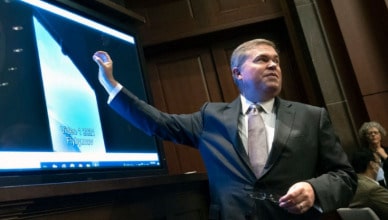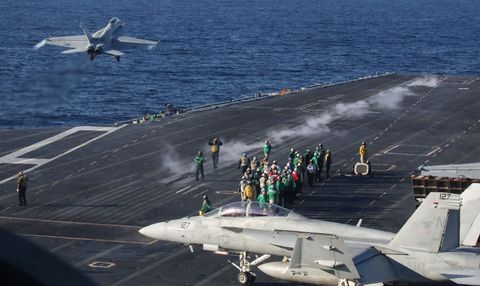- Congress has held its first hearing on unidentified flying objects (UFOs) in more than 50 years.
- The hearings addressed military sightings of UFOs in training areas and whether they posed a threat to pilots or national security.
- The Pentagon officials did not entirely rule out an extraterrestrial origin for the sightings.
Members of Congress quizzed government officials tasked with investigating sightings of unidentified flying objects for more than an hour yesterday.
The hearing, held by the House Intelligence Subcommittee on Counterterrorism, Counterintelligence and Counterproliferation, was the first on the subject of UFOs since 1968. Questions included whether or not the government had crashed UFOs in its possession and whether or not the Pentagon was investigating reports of flying saucers interfering with nuclear weapons.
Although the C3 Subcommittee may seem like a strange host for a hearing on UFOs, the questions primarily focused on sightings of unidentified aerial phenomena (UAPs) on military training ranges, and whether they represented a safety or security threat to U.S. military personnel. The reasoning is that if UAPs have a man-made origin, they could be intelligence operations against U.S. military forces conducting training.
Two Pentagon officials, Deputy Director of Naval Intelligence Scott Bray and Undersecretary of Defense for Intelligence and Security Ronald Moultrie, answered questions on the Pentagon’s recent UAP efforts.
The 2022 defense budget mandated that the Department of Defense create an agency to track UAP sightings. That agency, the Airborne Object Identification and Management Synchronization Group (AOIMSG), was tasked with, “scientific, operational, and technical analysis of data gathered by field investigations…to better understand and explain unidentified aerial phenomena.”
“Tuesday’s hearing was a step forward,” Nick Pope, a former UFO investigator for the United Kingdom’s Ministry of Defence, tells Popular Mechanics, “For far too long, this subject was unfairly stigmatized, and witnesses were disbelieved or ridiculed. That discouraged pilots and radar operators from speaking out, but a few brave ones did, and what happened on Tuesday is a testament to their courage and a vindication of their experiences.”
Rep. Adam Schiff reiterated a point made in the Pentagon’s June 2021 UAP report: Of the 144 UAP incidents between 2004 and 2021, 80 percent were recorded on multiple instruments. So-called “multi-sensor data” includes smartphones, video cameras, infrared cameras, and radar. Eighteen of the 144 incidents appeared to demonstrate “unusual flight characteristics that appeared to demonstrate advanced technology.”
Schiff asked if any of the 18 sightings appearing to demonstrate strange tech involved craft that emitted radiofrequency energy—possibly nodding to a 2004 incident when U.S. Navy pilots believed they were encountering anti-radar jamming from UAPs. Bray said some of the objects that did emit radiofrequency energy were not behaving “oddly otherwise,” which suggests that some of the radio wave-emitting UAPs could have been some form of man-made drone.
In response to another question, Bray admitted he was not aware of an adversary that could move an object “without a discernible means of propulsion,” but later said sensor artifacts could accidentally hide evidence of conventional propulsion. For example, a blurry pixel and a lack of detail might obscure a jet engine nozzle or a propeller. He also said some of the objects appeared to have “signature management,” which might include masking an object’s infrared or radar signatures in a similar manner to stealth aircraft such as the B-2 Spirit stealth fighter and the F-22 Raptor fighter.
The Pentagon officials exhibited two clips of video evidence. The first, apparently captured from a smartphone, shows a small spherical object that whisks past the cockpit of a U.S. Navy strike fighter in the blink of an eye. “I do not have an explanation for what this particular object is,” Bray said.
Bray and Moultrie then showed another video, taken off the West Coast in 2018, of what appears to be a flashing triangle, similar to a “swarm” of other objects reported by multiple U.S. Navy assets off a different coast.
“We are now reasonably confident these triangles correlate to unmanned aerial systems in the area,” Bray stated. The UAP’s triangular appearance, he explained, was the result of light “passing through the night vision goggles and then passing through the SLR camera,” and that the actual flying objects were not triangular in nature.
Article: Pentagon unveils shocking new UFO footage in congressional hearing

